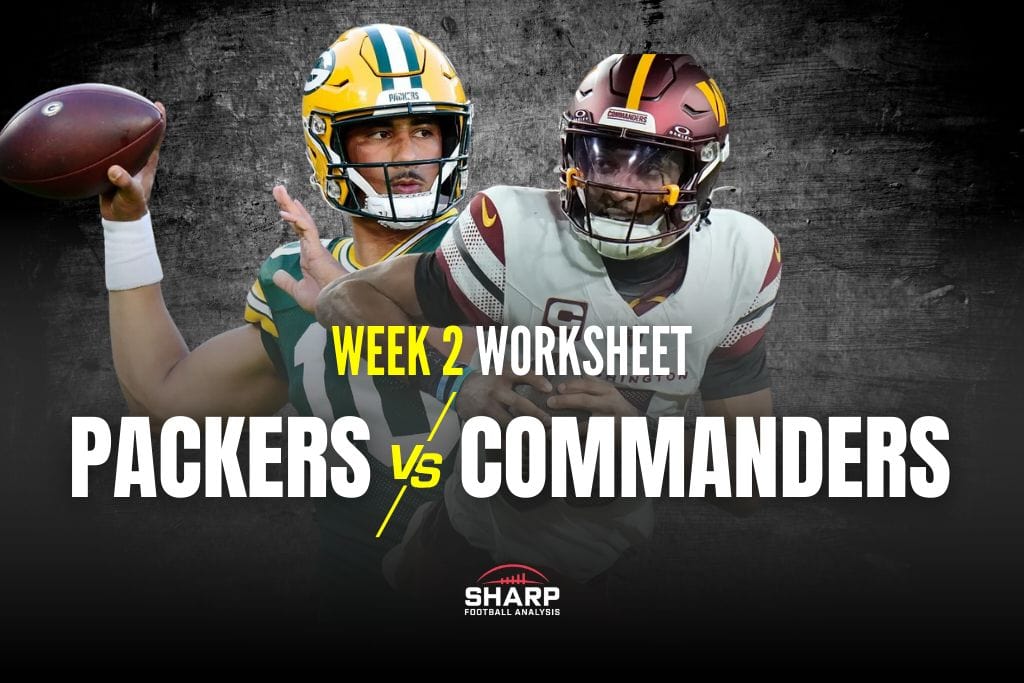The Worksheet, a comprehensive fantasy football preview by Rich Hribar, breaks down everything you need to know about the Week 2 matchup between the Packers and Commanders on Thursday Night Football.
Find a breakdown of every Week 2 NFL game in our Worksheet Hub.
| Washington | Rank | @ | Green Bay | Rank |
|---|---|---|---|---|
| 3.5 | Spread | 3.5 | ||
| 22.25 | Implied Total | 25.75 | ||
| 21.0 | 13 | Points/Gm | 27.0 | 6 |
| 6.0 | 1 | Points All./Gm | 13.0 | 6 |
| 65.0 | 9 | Plays/Gm | 47.0 | 31 |
| 62.0 | 16 | Opp. Plays/Gm | 65.0 | 23 |
| 6.6 | 2 | Off. Yards/Play | 5.7 | 10 |
| 3.7 | 3 | Def. Yards/Play | 3.8 | 4 |
| 49.23% | 10 | Rush% | 53.19% | 5 |
| 50.77% | 23 | Pass% | 46.81% | 28 |
| 37.10% | 8 | Opp. Rush % | 33.85% | 6 |
| 62.90% | 25 | Opp. Pass % | 66.15% | 27 |
- Green Bay was the only team without an offensive penalty in Week 1.
- Washington led the NFL with 19 plays of 10 or more yards in Week 1.
- Green Bay allowed a first down or touchdown on 9.1% of the runs they faced in Week 1, the lowest rate in the league.
- Washington produced a first down or touchdown on 34.4% of their Week 1 runs, fourth in the league.
- 57.9% of the completions for Washington went for 10 or more yards, the highest rate of Week 1.
- Green Bay was at 50% in Week 1, tied for fifth in the league.
- Only 25% of Washington running back runs were contacted at or behind the line of scrimmage, the lowest rate in the league in Week 1.
- Green Bay contacted Detroit running backs at or behind the line on 70% of their attempts in Week 1, the third-highest rate in the league.
Trust = spike production for that player
Quarterback
Jayden Daniels: Daniels picked up where he left off in his rookie season, finishing Week 1 with 20.1 fantasy points (QB13).
Since the start of last season, only Lamar Jackson has had more 20-point fantasy games than Daniels.
This was close to a floor outcome for Daniels, too.
He only accounted for 1 of the 3 offensive scores on Sunday, while the Giants provided next to no pushback on the scoreboard.
Washington only had a 46.7% dropback rate in the second half on Sunday, 28th in the league.
Despite the lack of touchdowns and pushback, Daniels boosted his fantasy line via rushing, adding 68 yards on the ground.
Only Jackson had more rushing yards among quarterbacks in Week 1.
Daniels scrambled on 10.8% of his dropbacks (QB5 on the week).
This matchup offers a lot more opportunity for a back-and-forth scoring environment, which helps the upside outcome for Daniels as a QB1.
This game can be explosive, which can create some added offensive tempo.
Even with the Giants providing little resistance, Daniels led the league with 23 dropbacks using no huddle, connecting on 12 of 17 of those passes for 8.5 yards per attempt.
While expecting Washington to need to score more points on Thursday, Green Bay’s defense is one to keep an eye on for taking another step forward this year.
They are coming off allowing only 3.8 yards per play to Detroit in Week 1, allowing 5.8 yards per pass attempt, and just one 20-yard passing play.
This was following a 2024 season in which the Packers ranked 8th in passing points allowed per game (12.9).
The Packers posted a 38.5% pressure rate on non-blitz dropbacks in Week 1 (7th).
Micah Parsons only played 30 snaps (45%), but he made an immediate impact.
With Parsons on the field, Jared Goff averaged 2.78 seconds per throw. 40.9% of his passes came out within 2.5 seconds.
With Parsons off the field, Goff averaged 3.12 seconds to throw. Only 23.8% of his throws came within 2.5 seconds of the snap.
Daniels was only pressured on 24.3% of his dropbacks in Week 1 (4th lowest), but he was sacked on 42.9% of his pressures (29th).
This was a slight problem as a rookie as well, with Daniels taking a sack on 25.8% of his pressures (31st).
But Daniels has still been a sturdy passer under pressure, throwing for 7.3 Y/A (third) and a 6.6% touchdown rate (7th) to open his career.
Daniels also has a league-high 23.5% scrambling rate when pressured to create rushing opportunities.
Jordan Love: Love was efficient in Week 1, connecting on 16 of 22 passes (72.7%) for 188 yards (8.5 Y/A) and 2 touchdowns, ending the week as QB16 (15.9 points).
Things could have been better for Love if he and the Packers had also received some push.
After Love opened the game strong, Green Bay reverted to the run-heavy offense it had shown a year ago.
The Packers had a 69.6% dropback rate in the first half on Sunday (6th), but then coasted after the half.
In the second half, Green Bay had a league-low 29.2% dropback rate.
Love threw only 6 passes in the second half, the fewest in Week 1.
This game environment has more potential for a competitive setting, making Love a viable upside option as a back-end QB1.
Washington also had a strong start in Week 1, albeit against a far less talented Giants offense.
The Commanders allowed only 4.5 Y/A on Sunday (4th), with a 45.9% completion rate (2nd).
Washington took advantage of the New York offensive line, creating pressure on 42.4% of their non-blitzes (2nd).
The quality of opponent ramps up here, but this Dan Quinn defense built on a strong second half of 2024, when they allowed 6.7 Y/A (fifth) and a 3.5% touchdown rate (fifth) over their final seven games.
Running Back
Josh Jacobs: Jacobs only managed 70 yards on 20 touches in Week 1, but he managed to find the end zone to smooth out his fantasy afternoon.
Jacobs operated as the bellcow once again, accounting for 86.9% of his backfield touches, which was RB6 to open the year.
Jacobs only caught one pass for four yards, but he was on the field for 65.2% of the dropbacks (RB8).
He remains a volume-based RB1.
Washington completely erased the Giants' backfield, allowing 30 yards on 15 runs, but this will be a larger test to see if they have flipped their run defense from a year ago.
In 2024, Washington allowed 4.9 yards per carry to running backs (30th) with 2.02 yards before contact per rush (31st).
The Packers are expected to be without Aaron Banks and Zach Thom up front, which are huge losses if they cannot go.
We saw in several spots in Week 1 that offensive play and availability was more of factor in rushing success, and Jacobs was already not overly efficient in Week 1.
Washington RBs: We saw all of Austin Ekeler, Bill Croskey-Merritt, and Jeremy McNichols play on Sunday, while Chris Rodriguez was a healthy scratch.
Ekeler led the backfield with 32 snaps but only managed 9 touches for 57 yards.
Washington used these backs in a compartmentalized fashion.
They ran the ball on only 28.1% of Ekeler’s snaps.
Ekeler is a floor-based FLEX in full-PPR formats.
Detroit running backs had 14 receptions against Green Bay in Week 1, but those only went for 49 yards.
Croskey-Merritt was second in snaps (19) and led the backfield with 10 touches for 82 yards and a touchdown.
The rookie had a 50% success rate as a runner (fifth) with a run of 10 or more yards on a league-high 30% of his runs.
He played 1 snap inside the 10-yard line.
He had a 6-yard touchdown run in his first game, also turning in a key block on Deebo Samuel‘s touchdown run.
Overall, this was as good an outcome as gamers had hoped for in Croskey-Merritt’s first game, earning more opportunities moving forward.
That said, his usage still places him in touchdown-dependent FLEX territory.
He only had 43.5% of the backfield touches (RB34) and only ran 7 pass routes (18.9% of the dropbacks).
If the Commanders do fall into a more negative game script this week as a road underdog, he becomes more fragile.
The Packers smothered the Detroit running game in Week 1, allowing 44 yards on 20 attempts and posting a 75% success rate on those runs (6th).
McNichols played 13 snaps, turning 4 touches into 25 yards.
Wide Receiver
Terry McLaurin: McLaurin started slow in Week 1, catching 2 of 4 targets for 27 yards.
He was behind the defense for a potential deep score to save his outing, but was overthrown on his one shot to turn things around.
McLaurin has now been held to fewer than 30 yards in three straight games against the Giants.
We also anticipated that McLaurin could start slow due to the recent trends for receivers who missed training camp and the addition of Deebo Samuel.
He only had 13.8% of the team's targets in Week 1.
He only had one game with a lower target rate in 2024.
McLaurin was targeted on only 12.1% of his routes.
He only had one game with a lower rate in 2024.
The good news is that McLaurin did not have any snap restrictions.
He was on the field for 89.2% of the team’s dropbacks.
This game offers plenty of appeal as a potential shootout, so do not run completely away from McLaurin’s Week 1 box score.
He is a boom-or-bust WR3.
Green Bay was excellent in Week 1, allowing 6.5 yards per target to Detroit wide receivers (9th).
They also were a strong downfield defense in 2024, allowing a 31.7% completion rate (9th) and a 52.8 rating (5th) on deep throws to wide receivers a year ago.
Deebo Samuel: Samuel had a stellar opening game with Washington, catching 7 of 10 targets for 77 yards and rushing for a 19-yard touchdown.
We talked about how Samuel was a strong fit for Kliff Kingsbury’s system, and this offense was desperate to add production after the catch.
Samuel had 39 yards after the catch and 5.6 YAC per reception in Week 1.
As a team, Washington wideouts averaged 4.5 YAC per reception in 2024.
The collective group of wideouts last year only had six games with more yards after the catch than Samuel had in Week 1.
That said, I would be surprised if Samuel has this wide a target gap over McLaurin weekly.
Samuel was targeted on 32.3% of his routes in Week 1.
Only three receivers were targeted at a higher rate with as many pass routes as Samuel to open the year.
For his career, Samuel has had a 23.3% target rate per route.
While we should see the targets tighten up between Samuel and McLaurin, this matchup could favor him again.
Green Bay played zone coverage at an 87.7% rate in Week 1 (3rd) after a 74.9% rate in 2024 (8th).
For his career, Samuel has been targeted on 25.3% of his routes against zone coverage compared to 20.1% against man coverage.
That makes sense given his targets near the line of scrimmage.
Paired with the potential to add some rushing yards, Samuel is on the WR2/WR3 line for Week 2.
Packers WRs: This was a sum of parts unit in Week 1.
Romeo Doubs led the wide receivers with a route on 73.9% of the dropbacks, catching 2 of 4 targets for 68 yards.
Matthew Golden ran 13 routes (56.5%), catching his 2 targets for 16 yards.
Jayden Reed played on his fractured foot, running 12 routes (52.2%) and catching 3 of 5 targets for 45 yards and a touchdown.
Dontayvion Wicks even worked in, running 9 routes and catching his two targets for 30 yards.
Outside of Golden’s usage, things played out as expected.
We know Doubs is the best bet for snaps at X, but he is reliant on touchdown production as a WR4/FLEX.
Reed is the best target earner, and that showed up again, with him drawing a target on a team-high 41.7% of his routes.
Given his foot injury, the Packers may still want to manage his snaps, but the snaps he does play will be attached to a high utilization rate.
That makes Reed a volatile WR4/FLEX.
Golden was limited due to an apparent ankle issue.
Golden drew a lot of defensive attention in Week 1 when he was on the field, but on a short week, we may not see his role extended even if he does play.
Golden was listed as a limited participant for Monday, but we will have to follow his status for Thursday.
As of now, Golden is still only a hold in fantasy formats.
If Golden does miss Thursday’s game, then all of the Green Bay wideouts get a boost in single-game DFS, with Wicks getting the largest bump in snap opportunities.
We do expect Green Bay to get more push and have more passing opportunities in Week 2.
Washington will face a better quarterback to go along with that volume than they did in Week 1, when they allowed a 52.4% completion rate (5th) and 6.0 yards per target (7th) to New York receivers.
Tight End
Tucker Kraft: Kraft only grabbed 2 of 4 targets for 16 yards on Sunday, but one of those was a 15-yard touchdown.
This has been the story for Kraft.
He has been a strong touchdown producer, but the overall passing volume has limited him in fantasy.
He has 6 or more targets in just three games since the start of last season.
Despite that, there are reasons to keep Kraft on the board as a touchdown-based TE1.
Kraft was on the field for a team-high 78.3% of the dropbacks, which was TE14 on the week.
Green Bay should have more overall passing volume here.
If Matthew Golden is limited or out, that opens more opportunities.
Washington was not tested in Week 1, but they allowed an 8.5% touchdown rate to tight ends in 2024 (31st in the league).
Zach Ertz: Ertz pulled down 3 of 5 targets for 26 yards and a touchdown in Week 1.
Ertz assumed the same role in the offense as a year ago, playing 81.1% of the dropbacks (TE12).
He lived on short touchdowns in 2024, so it is not surprising that he was propelled the same way in Week 1.
Ertz has a team-high 31.4% of the red zone targets since the start of last season.
Only Trey McBride (32.3%) has a higher share.
We wish we could bank on more targets and yards to elevate Ertz as more than a touchdown-based fantasy option, but the position is already thin if you are chasing a floor-based play with some touchdown equity.

More Week 2 Fantasy Breakdowns From The Worksheet:
| Matchup | Time |
|---|---|
| Commanders @ Packers | Thursday Night Football |
| Jaguars @ Bengals | Sunday -- 1 p.m. ET |
| Giants @ Cowboys | Sunday -- 1 p.m. ET |
| Bears @ Lions | Sunday -- 1 p.m. ET |
| Rams @ Titans | Sunday -- 1 p.m. ET |
| Patriots @ Dolphins | Sunday -- 1 p.m. ET |
| 49ers @ Saints | Sunday -- 1 p.m. ET |
| Bills @ Jets | Sunday -- 1 p.m. ET |
| Seahawks @ Steelers | Sunday -- 1 p.m. ET |
| Browns @ Ravens | Sunday -- 1 p.m. ET |
| Broncos @ Colts | Sunday -- 4:05 p.m. ET |
| Panthers @ Cardinals | Sunday -- 4:05 p.m. ET |
| Eagles @ Chiefs | Sunday -- 4:25 p.m. ET |
| Falcons @ Vikings | Sunday Night Football |
| Bucs @ Texans | Monday Night Football |
| Chargers @ Raiders | Monday Night Football |


















